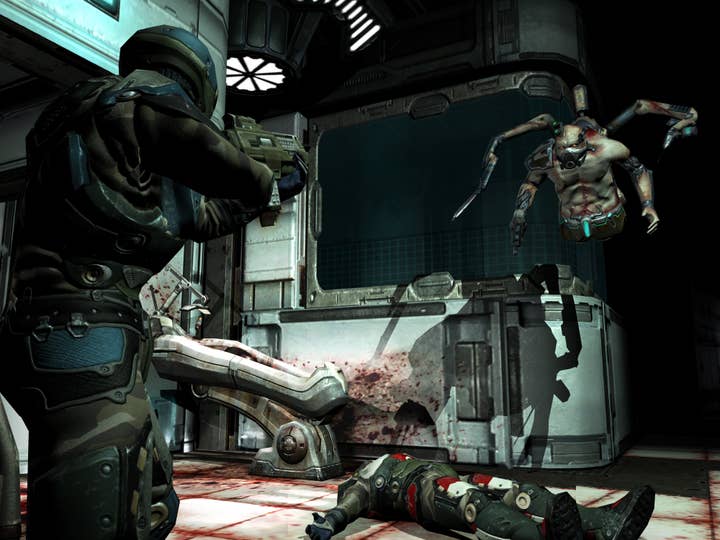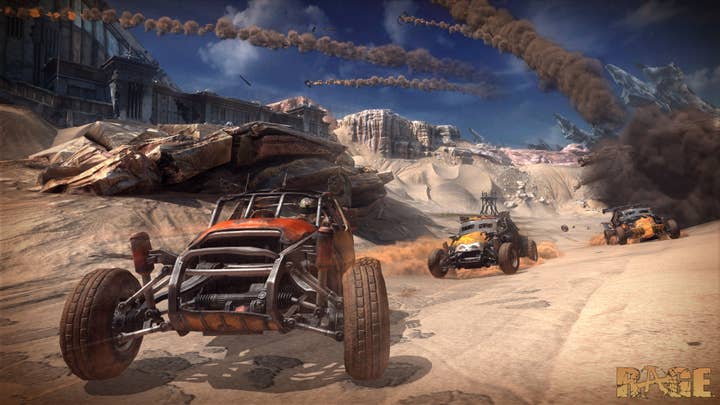Tech Focus: The Legacy of id Software
Digital Foundry on how the Rage creators shaped today's gaming technologies
Post Quake and its two sequels, development of id tech 4 resulted in spectacular advances in real-time lighting and shadowing - which defined the look of Doom 3 - id's most successful game to date, selling in excess of 3.5m copies with its graphical features propelling a new wave of GPU upgrades. Once again, id defined the bleeding edge of video game graphics on PC, with the developer leaving it to others to port its wares across to consoles.
Doom 3's arrival coincided with the release of Microsoft's Xbox - a console based on an Intel Celeron CPU and a custom NVIDIA graphics core: the core design manufacturers settled upon based in no small measure on the influence of id software and its games.
Arguably Call of Duty only exists because of id and its work. Indeed, even the most modern Infinity Ward titles continue to recognise licensed id code deep within its own proprietary engine
The announcement of Doom 3 for Xbox suggested that id could transition easily over to the next wave of consoles, and that its existing tech would work fine - something that couldn't be said for previous conversions of its work. While id would remain firmly a PC based developer in the here and now, its potential to reach out towards new audiences had increased exponentially. Could id conquer consoles?
Unfortunately when Doom 3 for Xbox eventually arrived eight months later, it didn't quite live up to expectations and the pattern was repeated when Quake 4 arrived as an early Xbox 360 title clearly running in an unoptimised state. The reliance of id on external studios to port across its games was producing sub-par results and the rise of the Xbox 360 and PS3 - combined with their encroachment on gaming markets traditionally associated with PC - resulted in id making its decision to focus first on console. The fixed console architecture had superceded the PC and the company had to adapt.


As Carmack puts it:
"We do not see the PC as the leading platform for games. That statement will enrage some people, but it is hard to characterise it otherwise; both console versions will have larger audiences than the PC version. A high-end PC is nearly 10 times as powerful as a console, and we could unquestionably provide a better experience if we chose that as our design point and we were able to expend the same amount of resources on it.
"Nowadays most of the quality of a game comes from the development effort put into it, not the technology it runs on. A game built with a tenth the resources on a platform ten times as powerful would be an inferior product in almost all cases."
The id heyday in defining both hardware and software for a generation of gamers has now come to a close but despite the tens of millions of dollars worth of development effort that has gone into new game Rage, there is something of a back to basics approach to what id is doing now from a technological standpoint. The company began life by extracting extraordinary performance from limited hardware with its side-scrolling Commander Kean shooters and this ethos is entirely consistent with what id and company have achieved with Rage.


John Carmack's Mega Texture technology makes impossibly good visuals come to life on the Xbox 360 and PlayStation 3 - and it does so at a solid 60 frames per second. Cast as a hibernating survivor of an apocalyptic meteor strike, the player's first experience of the new world id has created sees him emerging from his chamber, blinded by light, with a spectacular vista coming slowly into focus and opening out before him. The Wasteland is an enormous, hand-crafted environment impossibly rich in detail and stretching out way into the distance, and it runs so smoothly that it defies belief. It's a remarkable technological achievement, but as the critical consensus demonstrates, opinion is divided on the overall merits of the game - from a personal perspective, I absolutely love it.
Even if id's influence on the games business has diminished in recent years as console has taken over from PC, it's safe to say that its legacy is assured. The company didn't just define the FPS genre, it created it and with Call of Duty: Modern Warfare 3 almost certain to top the Christmas charts this year, it should be remembered that COD originated on id tech 3 from the Quake 3 Arena era. Arguably Call of Duty only exists because of id and its work. Indeed, even the most modern Infinity Ward titles continue to recognise licensed id code deep within its own proprietary engine.
As for John Carmack's opinion that you can either develop for console and get a better PC version, or instead develop for PC and get a sub-optimal console experience - the upcoming Battlefield 3 vs. Modern Warfare 3 bunfight should definitely put that theory to the test.
